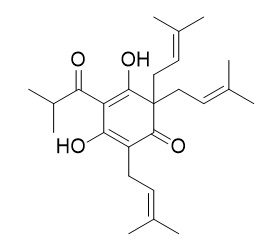Colupulone
Colupulone is an inducer of hepatic cytochrome P-4503A .Colupulone can increase cytochrome P450IIB and P450IIIA steady-state mRNA levels. Colupulone also has antibacterial effects.
Inquire / Order:
manager@chemfaces.com
Technical Inquiries:
service@chemfaces.com
Tel:
+86-27-84237783
Fax:
+86-27-84254680
Address:
1 Building, No. 83, CheCheng Rd., Wuhan Economic and Technological Development Zone, Wuhan, Hubei 430056, PRC
Providing storage is as stated on the product vial and the vial is kept tightly sealed, the product can be stored for up to
24 months(2-8C).
Wherever possible, you should prepare and use solutions on the same day. However, if you need to make up stock solutions in advance, we recommend that you store the solution as aliquots in tightly sealed vials at -20C. Generally, these will be useable for up to two weeks. Before use, and prior to opening the vial we recommend that you allow your product to equilibrate to room temperature for at least 1 hour.
Need more advice on solubility, usage and handling? Please email to: service@chemfaces.com
The packaging of the product may have turned upside down during transportation, resulting in the natural compounds adhering to the neck or cap of the vial. take the vial out of its packaging and gently shake to let the compounds fall to the bottom of the vial. for liquid products, centrifuge at 200-500 RPM to gather the liquid at the bottom of the vial. try to avoid loss or contamination during handling.
Inflammation.2015, 38(4):1502-16
Int J Mol Sci.2023, 24(6):5769.
Food and Agriculture Org. Of the UN2019, 151-160
Chem Biol Interact.2016, 258:59-68
Comput Biol Med.2024, 178:108775.
Evid Based Complement Alternat Med.2018, 2018:8565132
Int J Mol Sci.2015, 16(1):1232-51
Plants (Basel).2024, 13(23):3314.
Fitoterapia.2015, 100:179-86
University of Manitoba2023, 37433.
Related and Featured Products
J Appl Bacteriol. 1992 Apr;72(4):327-34.
Factors affecting antibacterial activity of hop compounds and their derivatives.[Pubmed:
1517174]
The antibacterial effect of weak acids derived from the hop plant (Humulus lupulus L.) increased with decreasing pH.
METHODS AND RESULTS:
Analysis of the minimum inhibitory concentration of such compounds against Lactobacillus brevis IFO 3960 over pH 4-7 suggests that undissociated molecules were mainly responsible for inhibition of bacterial growth. The antibacterial activity of trans-isohumulone was ca 20 times greater than that of humulone, 11 times greater than that of Colupulone and nine times greater than that of trans-humulinic acid when the degree of ionization was taken into account. Monovalent cations (K+, Na+, NH4+, Rb+, Li+) stimulated antibacterial activity of trans-isohumulone but the effect was smaller than that observed with H+.
The response to divalent cations varied: Ca2+ had little effect on antibacterial activity, whereas Mg2+ reduced activity. Lipid materials and beta-cyclodextrin also antagonized the antibacterial action of trans-isohumulone.
Food Chem Toxicol. 1994 Nov;32(11):1007-14.
The effect of colupulone (a HOPS beta-acid) on hepatic cytochrome P-450 enzymatic activity in the rat.[Pubmed:
7959454]
Colupulone, a component of hops, was examined for its ability to alter rat hepatic cytochrome P-450 enzymatic activity, expression of hepatic cytochrome P-450 mRNA, and in vitro promutagen activation.
METHODS AND RESULTS:
Colupulone was fed to male Sprague-Dawley rats for 5 days at 0.36% in the modified AIN 76 diet. Three cytochrome P-450 enzymatic activities were measured, and the corresponding steady-state mRNA levels were examined by Northern blot hybridization. Colupulone increased cytochrome P450IIB and P450IIIA steady-state mRNA levels. In vitro promutagen activation was measured in the Ames assay using liver homogenates from each treatment group. Colupulone treatment did not alter the ex vivo cytochrome P-450-mediated activation of aflatoxin B1 or benzo[a]pyrene to their mutagenic forms.
CONCLUSIONS:
The effect of long-term Colupulone administration on in vivo cytochrome P-450 enzymatic activity remains to be determined.
Mol Pharmacol. 2008 Dec;74(6):1512-20.
Structural basis of human pregnane X receptor activation by the hops constituent colupulone.[Pubmed:
18768384 ]
Hops extracts are used to alleviate menopausal symptoms and as an alternative to hormone replacement therapy, but they can produce potentially harmful drug-drug interactions. The nuclear xenobiotic receptor pregnane X receptor (PXR) is promiscuously activated by a range of structurally distinct chemicals. It has a key role in the transcriptional regulation of genes that encode xenobiotic metabolism enzymes.
METHODS AND RESULTS:
In this study, hops extracts are shown to induce the expression of numerous drug metabolism and excretion proteins. The beta-bitter acid Colupulone is demonstrated to be a bioactive component and direct activator of human PXR. The 2.8-A resolution crystal structure of the ligand binding domain of human PXR in complex with Colupulone was elucidated, and Colupulone was observed to bind in a single orientation stabilized by both van der Waals and hydrogen bonding contacts. The crystal structure also indicates that related alpha- and beta-bitter acids have the capacity to serve as PXR agonists as well.
CONCLUSIONS:
Taken together, these results reveal the structural basis for drug-drug interactions mediated by Colupulone and related constituents of hops extracts.



